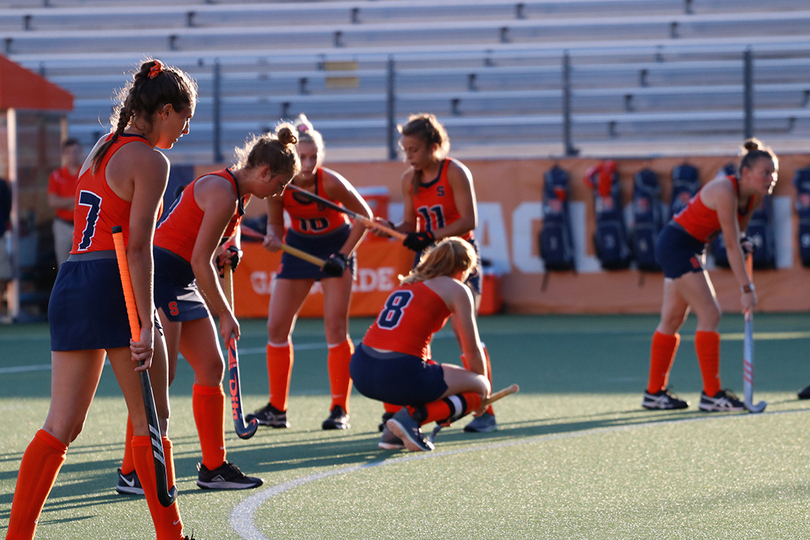Syracuse roster indicative of larger trends in U.S. field hockey

Since international players typically start playing field hockey at a younger age than Americans, they often have more refined skill sets. Elizabeth Hillman | Asst. Photo Editor
Not long after Carolin Hoffmann learned to talk and walk, she couldn’t wait to step on a field hockey pitch. Instead of adventuring into a nearby playroom, the German toddler eagerly watched her older brother’s practices from the sidelines.
And though the local club’s minimum age was three years old, one coach made an exception, allowing Hoffmann, then two-and-a-half, to play field hockey.
In European countries like Germany and the Netherlands where many SU players hail from, picking up field hockey in preschool — like Hoffmann did — is common. But in the United States, 32 out of 50 states have zero high schools that offer field hockey, according to the National Federation of State High School Associations (NFHS). Still, the sport’s popularity in the United States has improved in recent years, as the overall participation has grown by more than 1,000 high schoolers since 2015, per the NFHS.
“I think it’s getting bigger,” Claire Webb said of youth field hockey in the U.S., “So there’s more advertising for it, and it’s more out there. So, I think it would probably be easier now to start playing younger than back when I was starting to play.”
At Syracuse (8-3, 1-1 Atlantic Coast), the dichotomy between foreign-born and American players is clear. Most Americans on SU began playing field hockey as teenagers and some could only play club because their high schools didn’t have teams. They relied on their athleticism learned in other more popular sports to gain an advantage, while international players have honed their technical skills for longer, said junior Chiara Gutsche.
Webb began playing field hockey in third grade in Exton, Pennsylvania, earlier than all her other American teammates, she said. Webb’s mother played field hockey and introduced her to the sport, and it’s been “all I’ve ever known ever since,” Webb said. But she’s an exception.
“American play is a lot different,” junior midfielder Laura Graziosi said. “But, I mean, there’s a lot of internationals in college field hockey, so I think they also bring European play to the field hockey here.”
Amy Nakamura | Co-Digital Editor
Graziosi, who began field hockey in The Hague, Netherlands when she was five, has seven points, tied for second on the team. In the Netherlands, both men and women play field hockey, and it’s the second-most popular sport behind soccer, Graziosi said. Three of Syracuse’s top five point-scorers — including Charlotte de Vries — have international backgrounds. de Vries moved from Belgium to Pennsylvania at 11 years old.
One of the biggest challenges when an American player moves onto the collegiate level of field hockey, SU head coach Ange Bradley said, is adjusting to the different surface. American youth field hockey is almost always played on field turf — same as lacrosse or football fields — but that changes to AstroTurf in college.
Bradley compared the transition from field turf to AstroTurf to “playing basketball on ice” because of how much faster the college-level surface is.
“The physiological demands are completely different,” Bradley said, “And the ability to transition and do the next job — you gotta be able to think faster.”

Amy Nakamura | Co-Digital Editor
When junior Claire Cooke, who’s originally from Virginia, first came to Syracuse, it was the first time she’d played on AstroTurf. She began playing field hockey as a freshman in high school, relying on her athleticism she developed from soccer and lacrosse to earn a scholarship to Syracuse as a junior.
But Cooke remembers struggling to “keep up with the speed of things” on the faster turf, often losing control of the ball. She had to spend time after practices re-learning basic field hockey motions like sweeping. “It changes the entire game,” Cooke said.
While American-born players like Cooke have to adjust to what feels like a “completely different game” due to the new field, international players remain comfortable — they’ve been playing on AstroTurf for their whole lives.
“You learn so many skills when you’re younger,” Graziosi said. “When you’re older, obviously it’s harder to learn certain stuff. If you had already learned it younger, it’s easier to grow more.”




